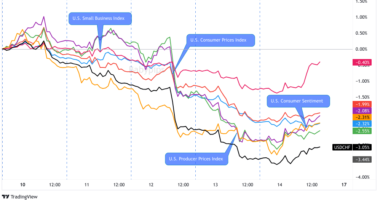
Last week’s U.S. reports pointed to slowing inflation and the Fed thinking twice about its tightening plans.
This week, the spotlight will be on growth and inflation trends for the other major economies. Will the releases help convince central banks and the markets to ease the pedal from the metal?
Before all that, ICYMI, I’ve written a quick recap of the market themes that pushed currency pairs around last week. Check it!
And now for the closely-watched potential market movers on the economic calendar this week:
China’s data dump
On Tuesday at 2:00 am GMT, we’ll get a closer look at the initial post-reopening activities for the world’s second largest economy.
Annual GDP is expected to accelerate from 2.9% to 3.2% in Q1 while the quarterly rate may improve from 0.0% to 1.7%. If you recall, People’s Bank of China (PBoC) Gov. recently confirmed the government’s expectations of a 5% growth for 2023.
Fixed asset investment may slip a bit from 5.5% to 5.3% ytd/y. However, annual industrial production is seen rising from 2.4% to 2.7% and industrial capacity utilization may improve from 75.7% to 76.3%.
On the consumer side, the unemployment rate is expected to tick lower from 5.6% to 5.5% while annual retail sales is seen jumping from 3.5% to 4.5% y/y in March.
Don’t forget that weaker-than-expected activity may encourage traders to price in more monetary help from the PBoC.
Inflation reports from Canada, Japan, U.K., and New Zealand
So U.S. consumer price increases slowed in March. Will we see the same trends for other major economies?
Canada’s (Apr 18, 12:30 pm GMT) annualized headline inflation is seen plummeting from 5.2% to 4.1% while core inflation could drop from 4.7% to 4.3%. Slower figures will support BOC’s expectations that inflation will decelerate to around 3% by mid-2023.
The U.K.’s headline CPI (Apr 19, 6:00 am GMT) might take a chill pill and dip to 9.8% y/y in March after a surprise jump from 10.1% to 10.4%. A surprise acceleration would go against BOE’s expectations of inflation decelerations for the rest of the year.
Inflation in New Zealand (Apr 19, 10:45 pm GMT) could also slow down, this time from 7.2% to 7.0% y/y in Q1. The quarterly rate might speed up a bit from 0.4% to 0.6%, however.
Finally, Japan’s (Apr 20, 11:30 pm GMT) annual headline inflation could dip from 3.3% to 3.2% but the more closely watched core inflation rate is seen steadying at its 3.2% y/y reading.
Flash manufacturing and services PMIs
It’s survey szn and you know what that means – we get another snapshot of business activity in the major economies! The bulk of the releases will come out on Friday (April 21) so y’all better not start your weekends early.
Japan’s (12:30 am GMT) manufacturing is seen improving from 49.2 to 49.9.
Eurozone PMIs have been upbeat recently, and April’s numbers aren’t expected to stop the trend though we could see weaknesses in the service sectors. France’s (7:15 am GMT) manufacturing could advance from 47.3 to 47.9 while services PMI could slow down from 53.9 to 53.6.
Meanwhile, Germany’s (7:30 am GMT) manufacturing PMI could bump up from 44.7 to 45.6 while the services PMI could slip from 53.7 to 53.2. Ditto for the Eurozone (8:00 am GMT), where manufacturing activity could improve from 47.3 to 47.9 while services PMI could dip from 55.0 to 54.6.
The U.K.’s (8:30 am GMT) services PMI could maintain its 52.9 reading while manufacturing activity is seen improving from 47.9 to 48.8.
And then there’s Uncle Sam (1:45 pm GMT), whose manufacturing and services activities could moderate a bit after a boost from China’s reopening.









